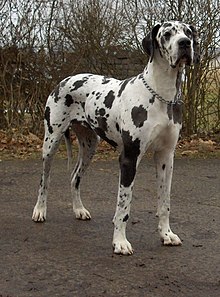Great Dane
 |
|||||||||||||||||||||||
| Other names | Deutsche Dogge German Mastiff |
||||||||||||||||||||||
|---|---|---|---|---|---|---|---|---|---|---|---|---|---|---|---|---|---|---|---|---|---|---|---|
| Common nicknames | Apollo of Dogs, Gentle Giant | ||||||||||||||||||||||
| Origin | Germany | ||||||||||||||||||||||
|
|||||||||||||||||||||||
|
|||||||||||||||||||||||
| Notes | State dog of Pennsylvania | ||||||||||||||||||||||
| Domestic dog (Canis lupus familiaris) | |||||||||||||||||||||||
| Traits | |||
|---|---|---|---|
| Weight | Male | minimum 110–180 lb (50–82 kg) | |
| Female | minimum 110–180 lb (50–82 kg) | ||
| Height | Male | minimum 30–31 in (76–79 cm) | |
| Female | minimum 28–30 in (71–76 cm) | ||
| Life span | 8 years | ||
| Classification / standards | |||
|---|---|---|---|
| FCI | Group 2, Section 2.1 Molossian: Mastiff type #235 | standard | |
| AKC | Working | standard | |
| CKC | standard | ||
| KC (UK) | Working | standard | |
| NZKC | Nonsporting | standard | |
| UKC | Guardian Dog | standard | |
The Great Dane is a large German breed of domestic dog known for its giant size. The German name of the breed is Deutsche Dogge, or German Mastiff. The French name is Dogue Allemand.
The Great Dane is one of the tallest dog breeds. The record holder for tallest dog was a Great Dane called Zeus (died September 2014; aged 5), that measured 111.8 cm (44.0 in) from paw to shoulder.Scooby-Doo is a famous fictional dog of this breed.
Large boarhounds resembling the Great Dane appear in ancient Greece, in frescoes from Tiryns dating back to the 14th–13th centuries BC.
These large boarhounds continue to appear throughout ancient Greece in subsequent centuries up to the Hellenistic era. The Molossian hound, Suliot dog, and specific imports from Greece were used in the 18th century to increase the stature of the boarhounds in Austria and Germany and the wolfhounds in Ireland.
Bigger dogs are depicted on numerous runestones in Scandinavia, on coinage in Denmark from the fifth century AD, and in the collection of Old Norse poems, known in English as Poetic Edda. The University of Copenhagen Zoological Museum holds at least seven skeletons of very large hunting dogs, dating from the fifth century BC to 1000 AD.
In the middle of the 16th century, the nobility in many countries of Europe imported strong, long-legged dogs from England, which were descended from crossbreeds between English Mastiffs and Irish Wolfhounds. They were dog hybrids in different sizes and phenotypes with no formal breed. These dogs were called Englische Docke or Englische Tocke – later written and spelled: Dogge – or Englischer Hund in Germany. The name simply meant "English dog". After time, the English word "dog" came to be the term for a molossoid dog in Germany and in France. Since the beginning of the 17th century, these dogs were bred in the courts of German nobility, independently of England.
...
Wikipedia
